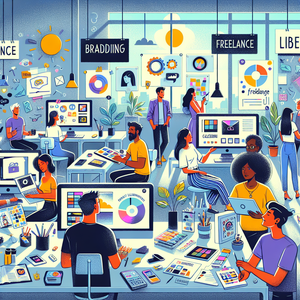
Your Path to Success: 15 Unique Career Opportunities for Aspiring Freelance Graphic Designers
Starting a freelance graphic design career is an exciting adventure filled with potential for creativity and innovation. However, thriving in this field requires more than just artistic flair; it also demands a keen understanding of business practices and effective client management. Various paths can lead to success, whether you pursue formal education or develop your skills independently. While some advocate for degrees in graphic design or related disciplines, many successful designers emphasize the importance of a robust portfolio and practical experience. Recognizing the diverse roles available within graphic design can help aspiring freelancers find their niche. Here, we explore 15 key career paths that can unlock your potential in this vibrant industry, along with the essential skills and qualifications needed for each role.
Job Summaries:
Freelance Graphic Designer:
- Freelance graphic designers are the backbone of visual communication, creating concepts that resonate with audiences.
- They handle client relations, project timelines, and finances independently.
- A compelling portfolio that showcases a variety of styles and a proficiency in tools like Adobe Creative Suite are crucial.
- While formal education can offer an advantage, many successful freelancers are self-taught.
- Essential skills include a grasp of branding, typography, and color theory, as well as the ability to adapt designs to meet specific client needs.
Branding Specialist:
- Branding specialists build and maintain a brand's visual identity.
- They craft elements like logos and style guides.
- A background in graphic design or marketing can be beneficial.
- Experience in brand strategy is important.
- Strong communication skills are vital for translating client visions into cohesive branding materials.
UI/UX Designer:
- UI/UX designers enhance user interactions with digital products by creating intuitive interfaces.
- A solid foundation in graphic design or web development is essential.
- Skills in tools like Figma are important.
- Understanding user psychology is key.
- Conducting research is essential to ensure designs are both functional and visually appealing.
Social Media Designer:
- Social media designers create eye-catching graphics tailored for various platforms.
- Familiarity with design tools like Canva and Adobe Spark is crucial.
- An understanding of marketing strategies is crucial.
- Collaboration with marketing teams helps align visual campaigns with broader objectives.
Illustrator:
- Illustrators use their artistic talents to produce images that convey stories across various media.
- A diverse portfolio showcasing unique styles is vital for attracting clients.
- Proficiency in both traditional and digital art tools like Procreate is necessary.
- Working closely with authors or marketing teams can lead to compelling visual narratives.
Print Designer:
- Print designers focus on creating stunning visuals for tangible products, such as brochures and packaging.
- A solid grasp of typography, color theory, and print production processes is critical.
- While a degree in graphic design can be beneficial, practical experience with printing techniques is equally important for ensuring designs translate well to physical formats.
Motion Graphic Designer:
- Motion graphic designers craft dynamic visuals for diverse media using software like Adobe After Effects.
- A strong storytelling foundation and knowledge of pacing are essential for creating engaging animations.
- This role is increasingly sought after for its ability to enhance narratives through motion.
Web Designer:
- Web designers are tasked with the visual aspects of websites, focusing on layout and user experience.
- Proficiency in HTML, CSS, and design software is necessary for creating attractive and functional websites.
- Often, a strong portfolio can outweigh formal education.
- Close collaboration with clients ensures their brand identity is represented accurately.
Packaging Designer:
- Packaging designers create appealing and functional product packaging that attracts consumers.
- A background in graphic design is essential, along with knowledge of materials and printing processes.
- This role is crucial as effective packaging significantly impacts product marketing.
Art Director:
- Art directors manage the visual direction of projects.
- Ensure designs align with client goals.
- Typically require a degree in graphic design.
- Several years of experience are needed.
- Strong leadership and communication skills are essential.
- Coordinate teams and oversee large-scale projects.
Layout Artist:
- Layout artists specialize in arranging visual elements for effective compositions in both print and digital formats.
- Mastery of software like Adobe InDesign is essential, along with a portfolio that showcases layout skills.
- Collaboration with clients and other designers helps ensure branding and messaging align.
Typography Specialist:
- Typography specialists focus on the art of arranging type to enhance both readability and aesthetic appeal.
- A deep understanding of font selection and layout is critical, accompanied by a portfolio highlighting typographic expertise.
- This role has gained importance as businesses aim to refine their visual communication.
Visual Identity Designer:
- Visual identity designers create the visual components that represent a brand, such as logos and color schemes.
- A degree in graphic design and a portfolio demonstrating branding work are typically required.
- This role is vital for establishing a cohesive brand image.
Digital Illustrator:
- Digital illustrators leverage digital tools to produce artwork for various applications.
- Proficiency in design software like Adobe Illustrator is essential.
- A portfolio that showcases unique artistic styles is important.
- Collaborating with clients is common to deliver customized illustrations.
Freelance Design Consultant:
- Freelance design consultants provide expert advice to businesses on enhancing their visual branding.
- A background in graphic design or marketing is often necessary, along with exceptional communication skills.
- This role is crucial in guiding brands toward successful visual identities.
By exploring these diverse opportunities, aspiring freelance graphic designers can identify paths that resonate with their skills and interests, setting the stage for a rewarding career in the creative realm. As the graphic design industry continues to evolve, a combination of creativity, technical proficiency, and business insight will be key to thriving in this dynamic landscape. Reflect on your individual strengths and passions, and take proactive steps toward realizing your potential in the world of freelance graphic design. For further insights and resources, consider consulting authoritative sources that can guide you on your journey to success.
Explore More Jobs

